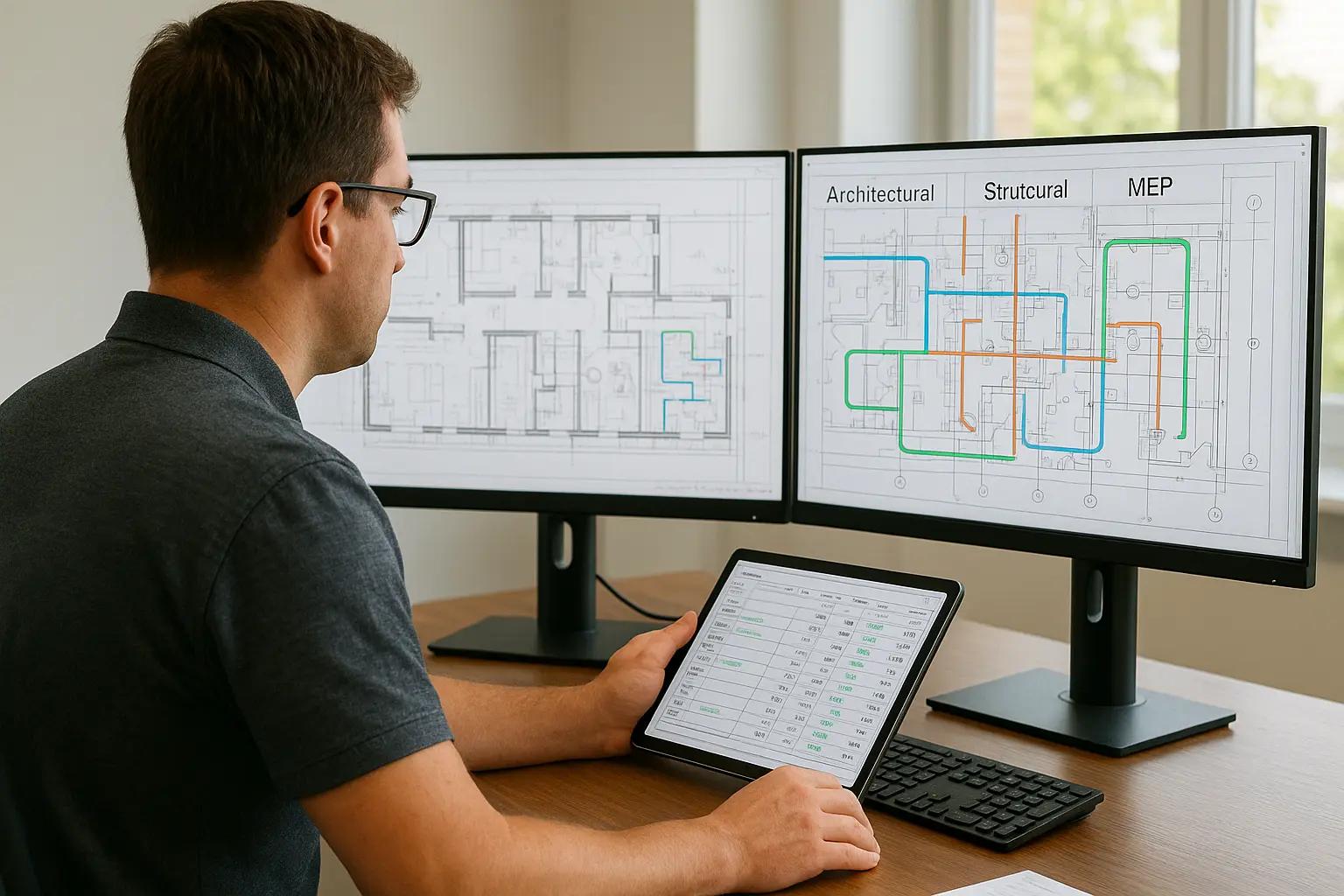Table of Contents
Commercial Estimation Workflow — A Complete Guide for Contractors
By Fusion Assist | Accurate Construction Estimates. Fast Turnaround. Real Results.
Introduction
A well-structured commercial estimation workflow is the backbone of profitable construction operations. Commercial projects involve larger scopes, tighter timelines, and higher financial stakes than residential work, making accuracy and consistency essential from the very first step. A reliable workflow not only ensures precise cost forecasting but also enhances decision-making, minimizes risk, and helps contractors compete effectively in highly demanding U.S. markets. The following business-driven and technically aligned workflow outlines how commercial estimators maintain precision, clarity, and strategic control throughout the pre-construction process.
Initial Project Overview and Requirement Analysis
Every estimation workflow begins with understanding the project holistically. Estimators start by reviewing architectural drawings, specifications, addenda, schedules, and owner requirements. The objective is to identify the project’s purpose, occupancy type, building classification, and code compliance obligations. At this stage, the estimator clarifies scope intent, delivery method, bid type, and expected timelines. This early insight helps assess whether the project fits the contractor’s capabilities, expected profit margin, and risk appetite. A deep initial analysis prevents assumption-based errors that often derail accurate cost forecasting.
Document Organization and Scope Breakdown
Commercial projects typically include a large number of drawings across multiple disciplines. Organizing these documents correctly is essential for efficient takeoff execution. Estimators create a structured sheet index, categorize drawings by trade, and highlight areas with overlapping responsibilities. Proper organization reduces confusion, prevents scope duplication, and ensures seamless review during addenda releases. From a business standpoint, this step also supports internal planning by clarifying manpower needs, trade involvement, and coordination requirements with subcontractors.
Detailed Quantity Takeoff Execution
The core technical phase of the workflow is the quantity takeoff. Using digital tools such as Bluebeam, PlanSwift, CostX, or On-Screen Takeoff, estimators measure areas, lengths, volumes, fixture counts, and material quantities with high precision. Commercial takeoffs involve complex system layouts, fire ratings, mechanical zoning, electrical routes, equipment locations, and structural assemblies. Each measurement is tagged to a relevant cost code, ensuring that pricing and reporting remain organized. Accurate takeoffs allow contractors to quote confidently and avoid the costly underestimations that frequently harm project profitability.
Cost Development and Pricing Integration
Once quantities are established, the estimator moves into pricing. This phase involves analyzing material costs, labor rates, equipment needs, fuel charges, logistics requirements, and vendor pricing. Commercial pricing also requires attention to trade-specific complexities such as union labor, prevailing wage mandates, night shifts, security requirements, and staging constraints. Estimators gather quotes from suppliers and subcontractors to ensure accuracy. Pricing must reflect current market conditions, material volatility, and real-world installation challenges. For businesses, strong pricing discipline directly contributes to competitive yet profitable bids.
Risk Analysis and Contingency Planning
Commercial construction carries inherent risks including design evolution, material shortages, inflation, and scheduling disruptions. In this stage, estimators assess financial exposure and assign balanced contingencies. Risks may include incomplete drawings, unclear specifications, site constraints, long lead items, weather impact, or complex installation sequencing. Contingency planning protects the contractor while keeping the bid competitive. A systematic risk strategy builds client trust and provides internal teams with a predictable financial buffer during execution.
Bid Summary and Proposal Preparation
After developing pricing, the estimator compiles a complete bid package. This package includes takeoff summaries, detailed pricing sheets, inclusions, exclusions, assumptions, clarifications, and alternates. Commercial clients expect proposals that demonstrate transparency, technical competence, and business readiness. The proposal must clearly communicate how the contractor interpreted the drawings and why the pricing represents an accurate reflection of scope. Well-prepared proposals significantly increase win rates because they offer clarity and reduce the need for lengthy follow-up requests.
Internal Review and Quality Control
Before submission, senior estimators or project managers conduct a thorough internal review. This validation step ensures that all scope items are accounted for, pricing matches the takeoff, assumptions are justified, and client requirements have been followed precisely. Internal review prevents costly mistakes, enhances accuracy, and reinforces accountability within the estimating team. For management, this stage ensures alignment with broader business objectives, margin requirements, and resource planning considerations.
Bid Submission and Client Coordination
Once approved internally, the bid is officially submitted. Submission formats vary depending on the client and may include digital portals, email, or sealed physical delivery. Timeliness is critical; late submissions are typically disqualified. After submission, estimators remain available to respond to questions, clarifications, or scope adjustments requested by the client. Strong communication at this stage enhances credibility and helps position the contractor favorably during evaluation.
Post-Bid Review and Negotiation
Following submission, estimators participate in negotiations, value engineering discussions, and revision cycles. Post-bid interactions reveal valuable information about client expectations, competitor pricing, and market trends. Even when a contractor does not win the job, analyzing feedback strengthens future strategy. If the project is awarded, the final pricing, assumptions, and clarifications form the foundation for pre-construction planning.
Continuous Improvement and Data Feedback Loop
The workflow concludes with performance analysis. Estimators review completed projects, compare estimated versus actual costs, analyze deviations, and refine internal databases. Maintaining historical cost data improves accuracy and streamlines future bids. This continuous improvement cycle helps contractors enhance forecasting precision and strengthen long-term profitability.
People Also Ask
What makes commercial estimation different from residential?
Commercial projects involve larger drawings, multi-trade systems, advanced code requirements, and complex coordination. The estimation workflow must be more structured, with deeper analysis and higher accuracy.
Why is document organization important in commercial estimating?
With dozens of sheets across multiple trades, organization prevents scope gaps, duplication, and missed items — all of which affect profitability.
How important are digital takeoff tools?
Critical. Bluebeam, PlanSwift, and similar tools ensure precision and reduce manual errors, especially in complex commercial environments.
Do contractors need subcontractor quotes for commercial bids?
Yes. Mechanical, electrical, fire protection, and specialty systems often require vendor or subcontractor pricing to ensure accuracy.
Why is risk analysis part of the workflow?
Commercial projects carry uncertainties such as design changes, lead times, and market volatility. Risk planning protects margins.
How does a strong workflow improve win rates?
It creates clear, consistent, professional proposals that clients trust — leading to higher bid success.




